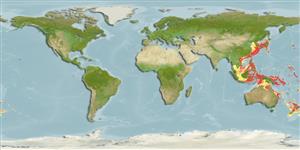Environment: milieu / climate zone / depth range / distribution range
Écologie
marin démersal. Tropical
Indo-Pacific.
Taille / Poids / Âge
Maturity: Lm ? range ? - ? cm
Max length : 61.5 cm TL mâle / non sexé; (Ref. 84366)
Description synthétique
Clés d'identification | Morphologie | Morphométrie
Vertèbres: 134 - 139. This moderately elongate species of Ophichthus, subgenus Coecilophis is distinguished by the following characters: tail 53-58%, head 11-13% of total length and depth at gill opening 4.0-4.8% of TL; origin of dorsal-fin slightly behind pectoral-tips; pectoral fins spatulate, non-elongate and slightly less than length; large eyes, posterior margin of orbit ahead of rictus; posterior nostril a hole in upper lip and covered by a flap; small, inconspicuous head pores, SO 1+3, IO 4+2, POM 2-3+6-7 (usually 3+7); small, conical teeth, uniserial on mandible and vomer, few anterior teeth on maxillary; color tan on flanks and dorsum, pale ventrally, all fins and anterior nostrils pale, chin and snout dusky; mean vertebral formula 16.2/54.0/136.5, total vertebrae 134-139 (Ref. 84366).
Taken from great depths, rarely from shallow muddy bottoms. Feeds on benthic animals (Ref. 637).
Life cycle and mating behavior
Maturities | Reproduction | Spawnings | Egg(s) | Fecundities | Larves
Masuda, H., K. Amaoka, C. Araga, T. Uyeno and T. Yoshino, 1984. The fishes of the Japanese Archipelago. Vol. 1. Tokai University Press, Tokyo, Japan. 437 p. (text). (Ref. 559)
Statut dans la liste rouge de l'IUCN (Ref. 130435)
Menace pour l'homme
Harmless
Utilisations par l'homme
Pêcheries: sans intérêt
Outils
Articles particuliers
Télécharger en XML
Sources Internet
Estimates based on models
Preferred temperature (Ref.
123201): 4.7 - 19.9, mean 13.2 °C (based on 353 cells).
Phylogenetic diversity index (Ref.
82804): PD
50 = 0.5000 [Uniqueness, from 0.5 = low to 2.0 = high].
Bayesian length-weight: a=0.00089 (0.00039 - 0.00204), b=3.00 (2.80 - 3.20), in cm total length, based on LWR estimates for this (Sub)family-body shape (Ref.
93245).
Niveau trophique (Ref.
69278): 3.5 ±0.37 se; based on food items.
Résilience (Ref.
120179): Milieu, temps minimum de doublement de population : 1,4 à 4,4 années (Preliminary K or Fecundity.).
Fishing Vulnerability (Ref.
59153): Moderate vulnerability (45 of 100).
